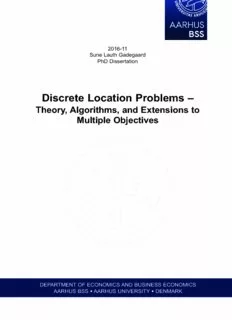
Discrete Location Problems PDF
Preview Discrete Location Problems
2016-11 Sune Lauth Gadegaard PhD Dissertation Discrete Location Problems – Theory, Algorithms, and Extensions to Multiple Objectives DEPARTMENT OF ECONOMICS AND BUSINESS ECONOMICS AARHUS BSS (cid:2) AARHUS UNIVERSITY (cid:2) DENMARK Discrete Location Problems – Theory, algorithms, and extensions to multiple objectives A PhD dissertation by Sune Lauth Gadegaard Aarhus BSS, Aarhus University Department of Economics and Business Economics. April 2016 Discrete Location Problems – Theory, algorithms, and extensions to multiple objectives Dissertation advisors – Lars Relund Nielsen (main) – Andreas Klose – Kim Allan Andersen Sune Lauth Gadegaard Department of Economics and Business Economics School of Business and Social Sciences Aarhus University Fuglesangs Allé 4 Building 2622 DK-8210 Denmark [email protected] http://pure.au.dk/portal/en/[email protected] Copyright (cid:13)c 2013-2016 Sune Lauth Gadegaard Rules of usage: None except the standard copyright rules. If any of the work, that being theory, computational results or figures, is used or reproduced in any way, cite the work and the author(s) in appropriate manners. Layout and typography is chosen and implemented by the author Font: Latin modern. 12pt scaled to 95 percent Produced with pdfLATEX and the memoir–class All figures have been made using TikZ To Irene who has the decency not to realize she is way out of my league and to Selma – You are my sunshine Table of contents Resumé (abstract in Danish) v Abstract vii Acknowledgments ix Notation xi 1 Introduction 1 1.1 Facility location problems . . . . . . . . . . . . . . . . . . . . . . . . . . . . . 2 1.1.1 A historic overview of facility location . . . . . . . . . . . . . . . . . 2 1.1.2 Characterizing facility location by topology and objective . . . . . . 6 1.2 Bi–objective facility location . . . . . . . . . . . . . . . . . . . . . . . . . . . 6 1.3 Contribution and outline of the dissertation . . . . . . . . . . . . . . . . . . . 9 2 An improved cut–and–solve algorithm for the single–source capacitated facility location problem 11 2.1 Introduction . . . . . . . . . . . . . . . . . . . . . . . . . . . . . . . . . . . . 13 2.2 Problem formulation . . . . . . . . . . . . . . . . . . . . . . . . . . . . . . . . 16 2.3 Solution methodology . . . . . . . . . . . . . . . . . . . . . . . . . . . . . . . 17 2.3.1 Phase 1 – Cutting planes . . . . . . . . . . . . . . . . . . . . . . . . . 18 Lifted cover inequalities . . . . . . . . . . . . . . . . . . . . . . . . . 21 Fenchel cutting planes . . . . . . . . . . . . . . . . . . . . . . . . . . 23 2.3.2 Phase 2 – Local branching . . . . . . . . . . . . . . . . . . . . . . . . 25 Initial feasible solution . . . . . . . . . . . . . . . . . . . . . . . . . . 25 Refining the locational decision . . . . . . . . . . . . . . . . . . . . . 26 Refining the allocation decision . . . . . . . . . . . . . . . . . . . . . 26 Heuristic stop criteria . . . . . . . . . . . . . . . . . . . . . . . . . . . 27 2.3.3 Phase 3 – Cut–and–solve . . . . . . . . . . . . . . . . . . . . . . . . . 27
Description: